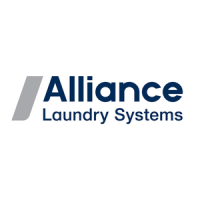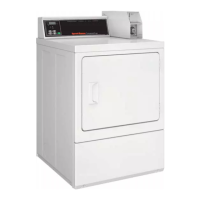Do you have a question about the Alliance Laundry Systems JT75CG and is the answer not in the manual?
Essential safety precautions to prevent fire, electric shock, injury, or death.
Recording purchase details and locating model/serial numbers for future reference.
Visual guide to finding the tumbler's identification nameplate for information.
Instructions on how to obtain literature and replacement parts for the tumbler.
Key physical measurements including height, width, and depth for installation planning.
Specifies exhaust connection points (diameter, across, height) for various models.
Details steam inlet/outlet connection points, including diameter, across, height, and span.
Specifies gas connection points, including diameter, across, and height for different tumbler models.
Illustrates electrical service connection points for gas/steam and electric models.
Procedures for inspecting the tumbler for shipping damage upon delivery.
Lists essential components that need to be sourced locally for installation.
Guidance on safely moving and placing the tumbler in its installation location.
Instructions for ensuring the tumbler is perfectly level for optimal operation.
Guidelines for building an enclosure around the tumbler, including clearance requirements.
Specifies floor load capacity and preparation requirements for tumbler installation.
Recommendations for tumbler placement, considering duct length and make-up air access.
Details on proper exhaust duct sizing, material, and installation for efficiency and safety.
Requirements for providing adequate air for combustion and ventilation, critical for gas models.
Illustrates gas piping configurations for multiple tumblers to ensure equal pressure.
Shows gas supply piping layout and calculations for 120 lb. tumblers.
Illustrates gas supply piping and calculations for 170 lb. tumblers.
Best practices for steam piping installation, including traps, unions, and insulation.
Step-by-step guide for connecting the steam supply to the solenoid valve.
Procedures for installing steam traps and connecting condensate return lines.
Essential guidelines for proper electrical grounding to prevent shock hazards.
Instructions for configuring jumpers on OPL micro-control models for voltage compatibility.
Guidance on installing a ring ferrite to protect electronic controls from electrical disturbances.
Step-by-step instructions for installing a new timing cam on coin meter models.
Procedure for safely removing the existing timing cam from the motor shaft.
Step-by-step guide for operating the manual dual timer tumbler.
Instructions for operating coin-operated tumblers, including drop and slide models.
How to adjust the air shutter for optimal combustion and flame pattern.
Procedure for adjusting the air flow switch for correct operation and safety.
Information on the air flow switch location and function for larger tumbler models.
Adjusting the cylinder door switch to ensure proper safety cutoff.
How to adjust the door strike for secure closure and proper switch activation.
Instructions for checking and adjusting belt tension on non-reversing belt drive models.
Steps for checking and adjusting chain tension on non-reversing chain drive models.
Guidance on adjusting belt tension for reversing belt drive models.
Step-by-step guide for operating the manual dual timer tumbler.
Instructions for operating coin-operated tumblers, including drop and slide models.
Explanation of the reversing feature and its benefits for load handling.
Overview of the OPL micro-control system for automated drying cycles.
How to select fabric type to set the appropriate drying temperature.
Guide to choosing and customizing drying cycles like Automatic, Time Dry, or Custom.
How to enable or disable the control panel lock-out feature.
How to adjust drying temperatures and switch between Fahrenheit and Celsius.
Daily procedure for cleaning the lint screen and compartment for optimal airflow.
Notes that bearings are pre-lubricated and require no additional lubrication.
Cleaning air vents, steam coils, and exhaust ducts every three months.
Instruction to check and adjust belt tension as needed.
Comprehensive inspection for loose connections, leaks, and proper grounding.
| Brand | Alliance Laundry Systems |
|---|---|
| Model | JT75CG |
| Category | Dryer |
| Capacity | 75 lb |
| Heat Source | Gas |
| Reversing Action | Yes |
| Type | Commercial |
| Phase | 1 or 3 |
| Amperage | 15A |
| Voltage | 120/240V |












